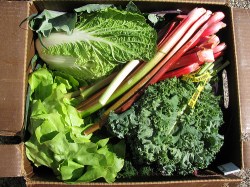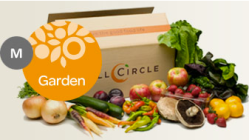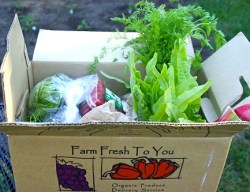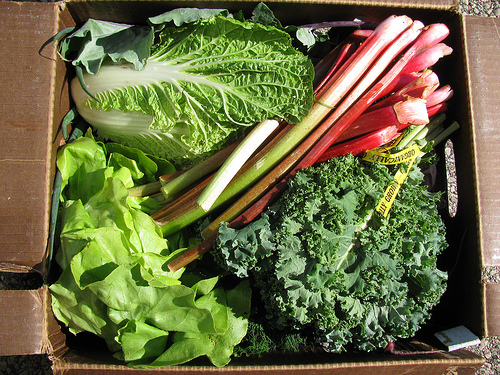
A traditional CSA box in spring is filled with mostly greens and rhubarb. Photo by Annemod.
My introduction to community-supported agriculture wasn’t through a real CSA at all, but through something called The Box — a generic subscription-based box of organic produce much like it sounds. My roommate and I were in our early 20s, sharing a one-bedroom, and we didn’t cook much. She suggested we go with a farm she’d heard of (there were only a handful of CSAs in the area at the time), but we both decided that we liked The Box’s huge selection, which wasn’t limited by location or season (they even had mangoes in winter).
In truth, The Box did very little to connect me with my foodshed; I didn’t learn anything about the farms behind the food nor, I’ll admit, did I care much at the time. On the other hand, it was through this service that I developed a borderline-unhealthy obsession with cooking everything we’d gotten one week before the next delivery arrived. I also learned that I liked chard, fava beans, and a few other seasonal foods I might not have tried. More importantly, I became a Person Who Got a Box of Organic Vegetables Every Week. And, looking back, that was a big step toward becoming the person I am today (a local food- and farm-obsessed gardener and home cook who reads and writes about food politics for a living).
This week, I was reminded of those early adventures with The Box while exploring the current state of the CSA — a subset of the organic food world that is at a crossroads, much like the larger organic industry. What started out as a great way for small farmers to reach a direct audience — a way for die-hard locavores to “buy in” to a single farm and take on the risks and the benefits of the year’s bounty — has gone mainstream, for better or worse.

The Full Circle box, by comparison, offers a variety less restricted by the seasons, from further away.
Take Full Circle, for example. It began as a tiny organic farm with a CSA program serving eaters in the Seattle area and grew to occupy three Washington state farms totaling 450 acres. Winter produce in the cool, wet Pacific Northwest can be pretty limited, so the service added foods from California, Mexico, and elsewhere, as well as organic groceries from around the country. Full Circle expanded to serve customers in Alaska, Eastern Washington, Idaho, and — as of this summer — the San Francisco Bay Area. Along the way, the company, which has reached over 15,000 members and works with 400 farms, dropped the term CSA from its marketing material and began calling itself an “organic produce delivery service.”
The Full Circle “membership” doesn’t require much more of a commitment than most online shopping sites. And — mainly because it offers food out of season — this new brand of CSA allows eaters to make a broad feel-good stroke at eating locally, without truly making many sacrifices. Once you’ve belonged to a “real” CSA, it might seem a little like cheating.

Full Circle founder Andrew Stout (click to see a video of Stout discussing his philosophy on growth).
As Andrew Stout, Full Circle’s founder and “chief farmer,” sees it, there is no downside to these changes if they can make membership more desirable to the masses. “The goal is to make small farms medium-sized and medium-sized farms big. CSAs cap out at a certain size. You can’t fully move the needle that way,” he told me on the phone recently. “I’m more concerned about the environmental impact of the conventional farming world, that GMO-filled world that is racing ahead. We need to have a counterbalance to that. At Full Circle, we want the industry to rise up, not settle down.”
Stout has a point. As the good food movement picks up steam, questions of scale and access are looming larger than ever. Yes, it’s been five years since the word “locavore” made it into the Oxford dictionary, but Big Food does still have a stranglehold on most of the country. Organic fruits and vegetables make up only 11 percent of all U.S. produce sales and organics added up to only 4 percent of food and beverage sales in 2010.
Full Circle is one of many companies looking to fill the so-called “middle space” between small-scale local farming and the big industrial stuff. Brooklyn’s Urban Organic, the Bay Area’s Golden Gate Organics, and SPUD — which is short for Sustainable Produce Urban Delivery, and, incidentally, bought The Box out a few years back — are all working with models that fill out a continuum. But, as you might guess, the more people they reach, the further away each company tends to move from the more intimate, farm-based model of the early CSA.
And this departure worries some locavores and organic pioneers. Or, as Elizabeth Henderson, author of Sharing the Harvest: A Citizen’s Guide to Community Supported Agriculture, wrote in a post for Grist earlier this year: “It seems many urban residents now see the CSA as just another form of ‘retail farming’ rather than a model for civic agriculture, a site-specific form of solidarity, or associative economics that can transform relationships.”
When Full Circle arrived in the Spokane area last year, Craig Goodwin, author of the book Year of Plenty and the blog with the same name, dug into the changes the company had recently undergone. He wrote:
… while they still seek to interpret the farmer relationships through printed materials that accompany the box, the connection to a local farm and farmers is no longer the defining center of what they are doing.
Goodwin acknowledged that the service still provides more of a connection to growers than your typical grocery store, but, in the end, he came down on the side of the more traditional CSA. “The ‘certified organic’ label is much less meaningful to me than having the food sourced from local farms and farmers,” he wrote.
Moving away from wholesale
Pat Herbert has been farming in central California since 1969. Relying on organic practices since 1990, Herbert specializes in peppers — most of which are sold to a company that freezes them. And until a few years back, the rest of the produce he grew went to the wholesale market — a common but very risky way to sell food. The farm went bankrupt in 2002 and Herbert has seen many of his crops go uneaten when the market drops (he’s worried about this year’s bumper crop of melons, for instance).
Today, around six of the 56 acres he farms go to fill boxes for Full Circle’s customers. “Full Circle is working to keep the customer base,” said Herbert — and that’s a big step. A company that size, he figures, is poised to grow — and that can only reduce his risk over time.

Photo by JennConspiracy.
Thaddeus Barsotti, farmer and co-owner of California’s 40,000-member CSA Farm Fresh to You agrees. He says that while farmers markets and single-farm CSAs have a place in supporting farmers, getting much more produce out of the wholesale market will go a long way toward truly building out a viable local food infrastructure.
“Produce is one of the most volatile markets. It’s supply and demand. The buyer’s job is to get the lowest price and they leverage farmers against each other. If farmers can get more than the harvest cost, they’ll often take it, because otherwise they’ll lose money. And that’s what puts farmers out of business,” Barsotti said. Indeed, one of best argument for what larger CSAs like his are doing is the fact that many farms with their own CSA programs still want to sell them their vegetables, over wholesale.
Barsotti and his brothers (the farm’s co-owners) are pushing for the best of both worlds: control over the farming system for all the food their company sells and a wide reach. And that’s part of why he hasn’t stopped using the term CSA to describe what Farm Fresh to You does.
Like Full Circle, Farm Fresh to You began as a small organic farm and has grown to incorporate other farms from around California and elsewhere — especially in the winter months.
During the summer, Farm Fresh to You produces around 80 percent of the produce going into the boxes. And unlike many larger producer delivery operations, Barsotti says he’s very involved with the partner farms. “I’m about delivering a process to a consumer,” he said. He doesn’t merely work with farms that are certified organic. Rather he works with them on their irrigation practices (insisting on drip rather than ditch irrigation), refuses to tolerate certain types of organic fertilizer, and also weighs in on their planting schedules.
On the other hand, members don’t currently have a way to read about the partner farms unless they’re featured in the Farm Fresh to You newsletter. (A search on the company’s website reveals the location from which each type of fruit and vegetable comes, but not the farm name. Barsotti says that a more transparent system is in the works.)
What’s missing
That transparency is — of course — what a lot of us are really drawn to about local food, as well as the sense of solidarity in hard times. In the case of Ohio farmer Bryn Bird — whose farm we featured in a recent Grist article about the drought — that intimate connection has made all the difference this summer, when Bird lost her entire crop of sweet corn to drought.
“We’re having lots of talks with our members — they’re expecting peppers by now, they want more tomatoes, etc.” she told me. “It’s a good chance to talk to our CSA members about the risks of eating local.” While her customers might be giving up this year’s corn on the cob, however, they’re trading it for a relationship that helps them keep next year’s produce in mind.
Then again, Bird’s CSA only reaches 210 people. And for now, it appears the vast majority of eaters don’t think a truly seasonal diet is worth it. The Barsottis’ company offers an option to receive only produce from neighbors in Capay Valley, the region where its farm is located. “It’s our least popular box,” he said. “Most prefer the four-season list with stuff from the [warmer] Salinas Valley.”
In the end, Barsotti said, “We’re taking local agriculture and increasing the acreage; that’s what a successful CSA does.” And Stout’s message is similar: “If you compare it with Walmart, you need hundreds if not thousands of services like Full Circle.”
My hope for these big CSAs is that they can forge ahead without putting the small farms that want to stay small out of business. Because the wider companies like these cast their nets, the more space it should make for some portion of their customer base to crave a more precise and rigorous farmer relationship than they can offer. I’m seeing a whole generation of eaters who start out as People Who Get a Box of Organic Vegetables Every Week and develop into People Willing to Do Whatever It Takes to Truly Fix Our Food System.



